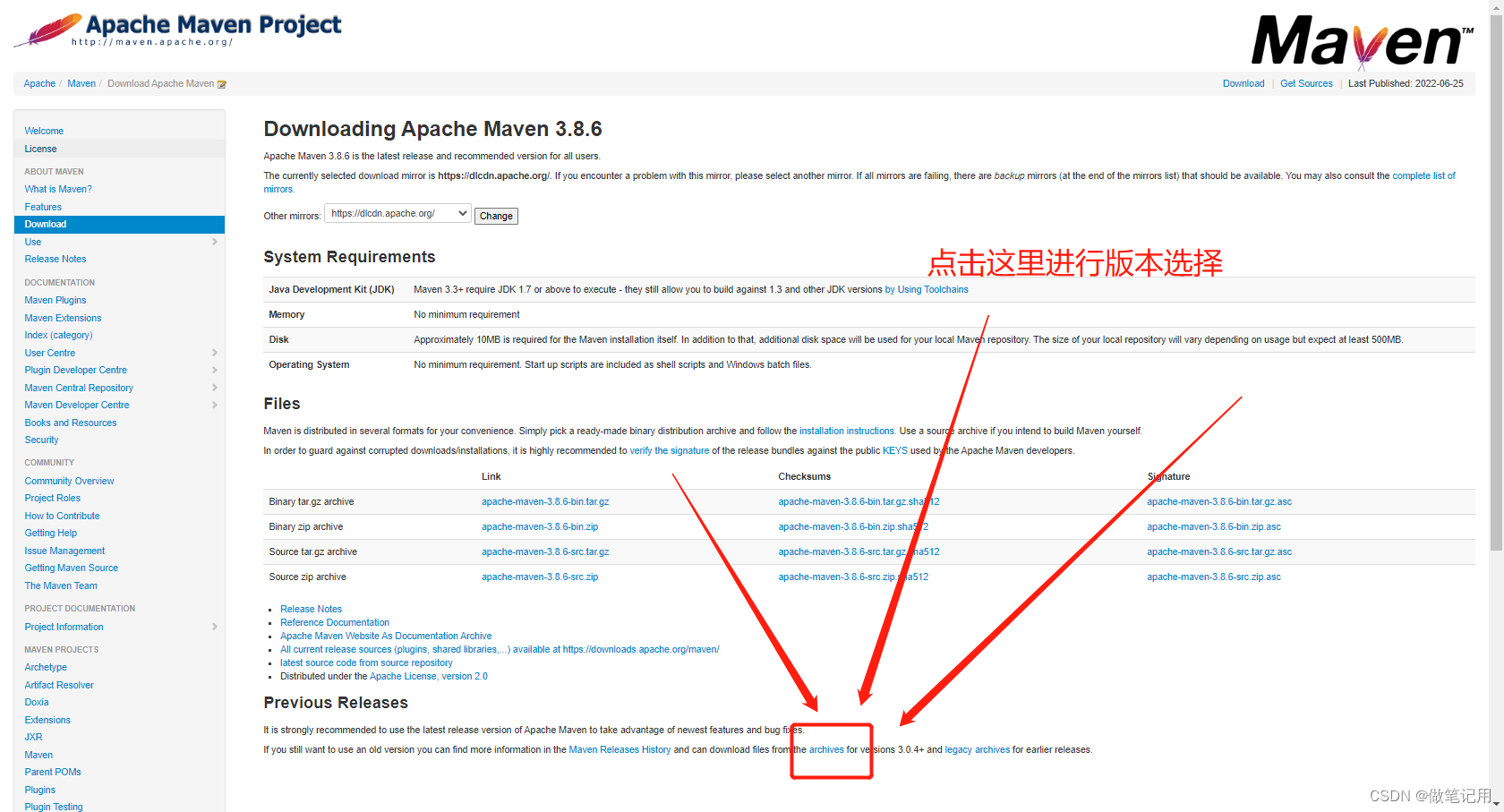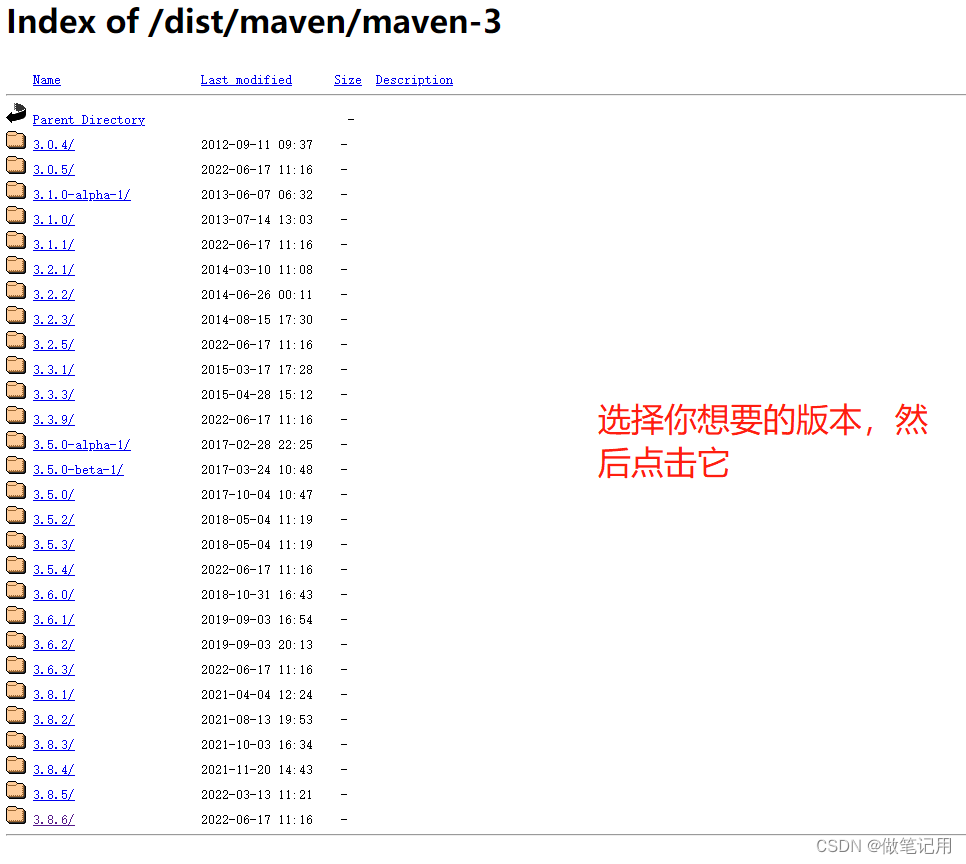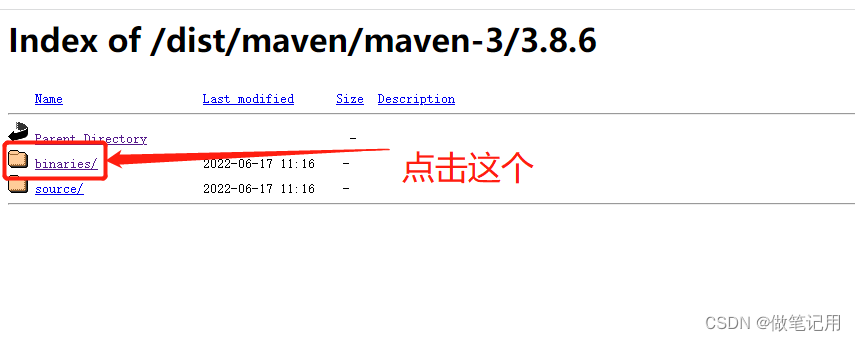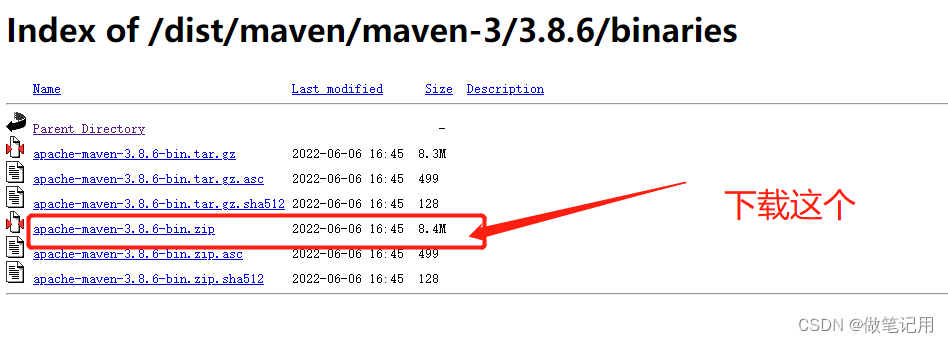2022最新版超详细的Maven下载配置教程、IDEA中集成maven(包含图解过程)、以及导入项目时jar包下载不成功的问题解决
maven教程:
https://blog.csdn.net/weixin_43304253/article/details/119815168
1、maven下载
官网地址:http://maven.apache.org/download.cgi




2、maven环境变量的配置


3、查看maven是否配置成功
配置成功会出现maven的安装版本以依赖的jdk版本

4、配置文件的修改
(可以直接复制粘贴下边的配置文件、只需要修改jar包仓库的位置)
- 1、修改jar包存放的位置
- 2、配置阿里云镜像
1、修改jar包存放的位置

2、配置阿里云镜像

setting.xml文件
<?xml version="1.0" encoding="UTF-8"?>
<!--
Licensed to the Apache Software Foundation (ASF) under one
or more contributor license agreements. See the NOTICE file
distributed with this work for additional information
regarding copyright ownership. The ASF licenses this file
to you under the Apache License, Version 2.0 (the
"License"); you may not use this file except in compliance
with the License. You may obtain a copy of the License at
http://www.apache.org/licenses/LICENSE-2.0
Unless required by applicable law or agreed to in writing,
software distributed under the License is distributed on an
"AS IS" BASIS, WITHOUT WARRANTIES OR CONDITIONS OF ANY
KIND, either express or implied. See the License for the
specific language governing permissions and limitations
under the License.
-->
<!--
| This is the configuration file for Maven. It can be specified at two levels:
|
| 1. User Level. This settings.xml file provides configuration for a single user,
| and is normally provided in ${user.home}/.m2/settings.xml.
|
| NOTE: This location can be overridden with the CLI option:
|
| -s /path/to/user/settings.xml
|
| 2. Global Level. This settings.xml file provides configuration for all Maven
| users on a machine (assuming they're all using the same Maven
| installation). It's normally provided in
| ${maven.conf}/settings.xml.
|
| NOTE: This location can be overridden with the CLI option:
|
| -gs /path/to/global/settings.xml
|
| The sections in this sample file are intended to give you a running start at
| getting the most out of your Maven installation. Where appropriate, the default
| values (values used when the setting is not specified) are provided.
|
|-->
<settings xmlns="http://maven.apache.org/SETTINGS/1.0.0"
xmlns:xsi="http://www.w3.org/2001/XMLSchema-instance"
xsi:schemaLocation="http://maven.apache.org/SETTINGS/1.0.0 http://maven.apache.org/xsd/settings-1.0.0.xsd">
<!-- localRepository
| The path to the local repository maven will use to store artifacts.
|
| Default: ${user.home}/.m2/repository
<localRepository>/path/to/local/repo</localRepository>
-->
<!--本地仓库的地址,存放jar包-->
<localRepository>E:\maven\repository</localRepository>
<!-- interactiveMode
| This will determine whether maven prompts you when it needs input. If set to false,
| maven will use a sensible default value, perhaps based on some other setting, for
| the parameter in question.
|
| Default: true
<interactiveMode>true</interactiveMode>
-->
<!-- offline
| Determines whether maven should attempt to connect to the network when executing a build.
| This will have an effect on artifact downloads, artifact deployment, and others.
|
| Default: false
<offline>false</offline>
-->
<!-- pluginGroups
| This is a list of additional group identifiers that will be searched when resolving plugins by their prefix, i.e.
| when invoking a command line like "mvn prefix:goal". Maven will automatically add the group identifiers
| "org.apache.maven.plugins" and "org.codehaus.mojo" if these are not already contained in the list.
|-->
<pluginGroups>
<!-- pluginGroup
| Specifies a further group identifier to use for plugin lookup.
<pluginGroup>com.your.plugins</pluginGroup>
-->
</pluginGroups>
<!-- proxies
| This is a list of proxies which can be used on this machine to connect to the network.
| Unless otherwise specified (by system property or command-line switch), the first proxy
| specification in this list marked as active will be used.
|-->
<proxies>
<!-- proxy
| Specification for one proxy, to be used in connecting to the network.
|
<proxy>
<id>optional</id>
<active>true</active>
<protocol>http</protocol>
<username>proxyuser</username>
<password>proxypass</password>
<host>proxy.host.net</host>
<port>80</port>
<nonProxyHosts>local.net|some.host.com</nonProxyHosts>
</proxy>
-->
</proxies>
<!-- servers
| This is a list of authentication profiles, keyed by the server-id used within the system.
| Authentication profiles can be used whenever maven must make a connection to a remote server.
|-->
<servers>
<!-- server
| Specifies the authentication information to use when connecting to a particular server, identified by
| a unique name within the system (referred to by the 'id' attribute below).
|
| NOTE: You should either specify username/password OR privateKey/passphrase, since these pairings are
| used together.
|
<server>
<id>deploymentRepo</id>
<username>repouser</username>
<password>repopwd</password>
</server>
-->
<!-- Another sample, using keys to authenticate.
<server>
<id>siteServer</id>
<privateKey>/path/to/private/key</privateKey>
<passphrase>optional; leave empty if not used.</passphrase>
</server>
-->
</servers>
<!-- mirrors
| This is a list of mirrors to be used in downloading artifacts from remote repositories.
|
| It works like this: a POM may declare a repository to use in resolving certain artifacts.
| However, this repository may have problems with heavy traffic at times, so people have mirrored
| it to several places.
|
| That repository definition will have a unique id, so we can create a mirror reference for that
| repository, to be used as an alternate download site. The mirror site will be the preferred
| server for that repository.
|-->
<mirrors>
<!-- mirror
| Specifies a repository mirror site to use instead of a given repository. The repository that
| this mirror serves has an ID that matches the mirrorOf element of this mirror. IDs are used
| for inheritance and direct lookup purposes, and must be unique across the set of mirrors.
|
<mirror>
<id>mirrorId</id>
<mirrorOf>repositoryId</mirrorOf>
<name>Human Readable Name for this Mirror.</name>
<url>http://my.repository.com/repo/path</url>
</mirror>
-->
<!-- 阿里镜像仓库 -->
<mirror>
<id>alimaven</id>
<name>aliyun maven</name>
<url>
http://maven.aliyun.com/nexus/content/groups/public/
</url>
<mirrorOf>central</mirrorOf>
</mirror>
</mirrors>
<!-- profiles
| This is a list of profiles which can be activated in a variety of ways, and which can modify
| the build process. Profiles provided in the settings.xml are intended to provide local machine-
| specific paths and repository locations which allow the build to work in the local environment.
|
| For example, if you have an integration testing plugin - like cactus - that needs to know where
| your Tomcat instance is installed, you can provide a variable here such that the variable is
| dereferenced during the build process to configure the cactus plugin.
|
| As noted above, profiles can be activated in a variety of ways. One way - the activeProfiles
| section of this document (settings.xml) - will be discussed later. Another way essentially
| relies on the detection of a system property, either matching a particular value for the property,
| or merely testing its existence. Profiles can also be activated by JDK version prefix, where a
| value of '1.4' might activate a profile when the build is executed on a JDK version of '1.4.2_07'.
| Finally, the list of active profiles can be specified directly from the command line.
|
| NOTE: For profiles defined in the settings.xml, you are restricted to specifying only artifact
| repositories, plugin repositories, and free-form properties to be used as configuration
| variables for plugins in the POM.
|
|-->
<profiles>
<!-- profile
| Specifies a set of introductions to the build process, to be activated using one or more of the
| mechanisms described above. For inheritance purposes, and to activate profiles via <activatedProfiles/>
| or the command line, profiles have to have an ID that is unique.
|
| An encouraged best practice for profile identification is to use a consistent naming convention
| for profiles, such as 'env-dev', 'env-test', 'env-production', 'user-jdcasey', 'user-brett', etc.
| This will make it more intuitive to understand what the set of introduced profiles is attempting
| to accomplish, particularly when you only have a list of profile id's for debug.
|
| This profile example uses the JDK version to trigger activation, and provides a JDK-specific repo.
<profile>
<id>jdk-1.4</id>
<activation>
<jdk>1.4</jdk>
</activation>
<repositories>
<repository>
<id>jdk14</id>
<name>Repository for JDK 1.4 builds</name>
<url>http://www.myhost.com/maven/jdk14</url>
<layout>default</layout>
<snapshotPolicy>always</snapshotPolicy>
</repository>
</repositories>
</profile>
-->
<!--
| Here is another profile, activated by the system property 'target-env' with a value of 'dev',
| which provides a specific path to the Tomcat instance. To use this, your plugin configuration
| might hypothetically look like:
|
| ...
| <plugin>
| <groupId>org.myco.myplugins</groupId>
| <artifactId>myplugin</artifactId>
|
| <configuration>
| <tomcatLocation>${tomcatPath}</tomcatLocation>
| </configuration>
| </plugin>
| ...
|
| NOTE: If you just wanted to inject this configuration whenever someone set 'target-env' to
| anything, you could just leave off the <value/> inside the activation-property.
|
<profile>
<id>env-dev</id>
<activation>
<property>
<name>target-env</name>
<value>dev</value>
</property>
</activation>
<properties>
<tomcatPath>/path/to/tomcat/instance</tomcatPath>
</properties>
</profile>
-->
</profiles>
<!-- activeProfiles
| List of profiles that are active for all builds.
|
<activeProfiles>
<activeProfile>alwaysActiveProfile</activeProfile>
<activeProfile>anotherAlwaysActiveProfile</activeProfile>
</activeProfiles>
-->
</settings>
5、IDEA集成maven

6、导入项目时jar包下载不成功的问题解决
我在跑项目时遇到的问题
拉取一个新的项目、jar包依赖出现问题、导致项目跑不起来
思路:
1、换个网络重新下载
2、查看IDEA集成maven的地址是否正确
3、查看maven配置文件中的仓库地址是否正确
4、查看jar包仓库中是否有爆红jar包(我的是文件中有对应的jar包、但是idea中说找不到依赖)
5、下载jar包后、重启idea(有的时候能解决)
6、重启电脑、(我也成功解决过)
7、直接跑项目(可能会成功)
2022最新版超详细的Maven下载配置教程、IDEA中集成maven(包含图解过程)、以及导入项目时jar包下载不成功的问题解决的更多相关文章
- json教程系列(1)-使用json所要用到的jar包下载
json是个非常重要的数据结构,在web开发中应用十分广泛.我觉得每个人都应该好好的去研究一下json的底层实现,基于这样的认识,金丝燕网推出了一个关于json的系列教程,分析一下json的相关内容, ...
- hadoop入门篇---超详细hadoop服务器环境配置教程
虚拟机以及Linux系统安装在之前的两篇分享中已经详细的介绍了方法,并且每一步的都配图了.如果有朋友还是看不懂,那我也爱莫能助了.本篇主要就hadoop服务器操作系统配置进行详细说明,hadoop安装 ...
- Maven下载项目依赖jar包和使用方法
一.Maven3.5.0安装与配置+Eclipse应用 参考:Maven3.5.0安装与配置+Eclipse应用 二.http://mvnrepository.com/ 此处以http://mvnre ...
- 超详细的Xcode代码格式化教程,可自定义样式。
超详细的Xcode代码格式化教程,可自定义样式. 为什么要格式化代码 当团队内有多人开发的时候,每个人写的代码格式都有自己的喜好,也可能会忙着写代码而忽略了格式的问题.在之前,我们可能会写完代码后,再 ...
- (原创)超详细一步一步在eclipse中配置Struts2环境,无基础也能看懂
(原创)超详细一步一步在eclipse中配置Struts2环境,无基础也能看懂 1. 在官网https://struts.apache.org下载Struts2,建议下载2.3系列版本.从图中可以看出 ...
- 超详细从零记录Hadoop2.7.3完全分布式集群部署过程
超详细从零记录Ubuntu16.04.1 3台服务器上Hadoop2.7.3完全分布式集群部署过程.包含,Ubuntu服务器创建.远程工具连接配置.Ubuntu服务器配置.Hadoop文件配置.Had ...
- (转)Maven依赖的jar包下载不了、jar更新不了的解决办法
场景一: 使用Maven的同学可能偶尔会遇到这种情况:pom.xml中依赖了项目需要的某个jar文件,但是使用Maven –> update project 还是没办法下载该jar到项目中,你可 ...
- 超详细!Github团队协作教程(Gitkraken版)
超详细!Github团队协作教程(Gitkraken版) 一.前期工作 1. 在 Github 上创建 organization step1. 登录Github网站,点击右上角头像,选择 " ...
- 通过Maven将指定Jar包下载到指定的本地目录
现在大家大部分都通过Maven等工具来管理包,但是特殊情况下还是需要将包下载到本地.我们可以通过maven命令来完成这个需求.创建一个pom.xml文件,文件内容如下: <?xml versio ...
随机推荐
- day15--Java常用类之日期相关类
Java常用类 3.日期相关类 3.1Date类 在标准Java类库中包含一个Date类,它的对象表示一个特定的瞬间,精确到毫秒.在网上商城下单时,在对报销单进行审核时,都需要获取当前的时间,通过Da ...
- django自带的序列化组件
1.什么是序列化组件 在django中,自带一个序列化组件,它是用来将数据进行整理.转化成特定的为一个特定的格式(比如json数据格式),然后传输给前端,以便前端对数据进行处理操作. 2.为什么要用序 ...
- Docker 04 容器命令
参考源 https://www.bilibili.com/video/BV1og4y1q7M4?spm_id_from=333.999.0.0 https://www.bilibili.com/vid ...
- 从C过渡到C++——换一个视角深入数组[真的存在高效吗?](2)
从C过渡到C++--换一个视角深入数组[真的存在高效吗?](2) C风格高效的数组遍历 在过渡到C++之前我还是想谈一谈如何书写高效的C的代码,这里的高效指的是C代码的高效,也就是在不开启编译器优化下 ...
- 从C过渡到C++——换一个视角深入数组[初始化](1)
从C过渡到C++--换一个视角深入数组[初始化](1) 目录 从C过渡到C++--换一个视角深入数组[初始化](1) 数组的初始化 从C入手 作用域 代码块作用域 文件作用域 原型作用域 函数作用域 ...
- 057_末晨曦Vue技术_处理边界情况之强制更新和创建低开销的静态组件
强制更新和创建低开销的静态组件 点击打开视频讲解更加详细 强制更新 如果你发现你自己需要在 Vue 中做一次强制更新,99.9% 的情况,是你在某个地方做错了事. 你可能还没有留意到数组或对象的变更检 ...
- C# 数组 深拷贝 和 数组传参
前言 C#中引用类型无法使用const,因此传参的时候使用引用类型,一定要注意是否会改变其值.下面介绍几种 数组的 深拷贝方法. 前提 下面的测试代码有一些前提, sw为Stopwatch nForT ...
- 前端Long类型丢失精度问题
有时候后端向前端传输Long类型,数字过长会出现丢失精度的问题 比如后端传来的是这样一个长数字串 那么前端的弹窗显示的是  -v 容器绝对路径 或者 -v 已经创建的volume名称:容器绝对路径 2. 使用挂载点(共享宿主目 ...
- win10电脑自动连接蓝牙设备攻略
每次在电脑上想连接蓝牙耳机,但不想手动去连接怎么办呢? 自动连接! 其实微软已经解决了这个问题,只要打开蓝牙,他就会自动匹配上次连接的设备 打开设置--->设备勾选 "显示使用&quo ...
